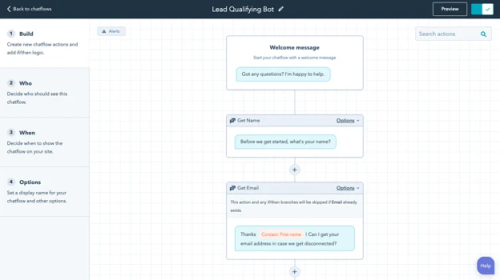In today’s fast-paced digital landscape, where instant communication is the norm, businesses are turning to all kinds of different solutions to enhance user experience and streamline customer interactions. One of those solutions making waves is the chatbot. After all, who wouldn’t want a virtual assistant at their fingertips that’s ready to engage with users 24/7, provide instant responses, and significantly improve overall customer satisfaction?
It’s pretty safe to say we could all benefit from this in some capacity. Let’s take a look at how HubSpot’s chatbot can make your life easier while improving the customer experience at the same time.

How do HubSpot Chatbots improve the user experience?
Instant Responses
24/7 Availability: Chatbots provide instant responses to user queries, eliminating the need to wait for human assistance. This 24/7 availability enhances the overall user experience by ensuring users can get help whenever they need it.
Efficiency and Speed
Quick Problem Resolution: Chatbots can quickly analyze user inputs and provide solutions or information faster than traditional support channels. The happiest customers get answers right away.
Personalization
User Profiling: Chatbots can be designed to collect and remember user preferences, making interactions more personalized. We all want to feel special – this personalization contributes to a more tailored and enjoyable user experience.
User Guidance and Assistance
Onboarding Assistance: Chatbots can guide users through onboarding processes, helping them understand how to use a product or service effectively. This guidance enhances the overall user experience, especially for new users that are just getting their feet wet.
Handling Repetitive Tasks
Automation of Routine Queries: Chatbots excel at handling repetitive and routine tasks, such as providing FAQs or retrieving specific information. This frees up human agents to focus on more complex issues, improving the overall efficiency of customer support.
Multichannel Engagement
Seamless Transitions: Chatbots can operate across various channels, including websites, messaging apps, and social media. The seamless transitions between channels provides users with a consistent, integrated experience.
Data Collection and Feedback
User Feedback: Chatbots can collect user feedback and preferences during interactions. This data can be invaluable for businesses to improve their products or services based on user input, contributing to a more user-centric experience.
Cost-Effective Customer Support
Scalability: Chatbots can handle a large number of simultaneous conversations, making them a cost-effective solution for businesses with high support volumes. This scalability ensures that users don’t face long wait times, leading to a better experience.
Continuous Improvement
Learning and Adaptation: Chatbots can learn from user interactions over time, becoming more proficient in understanding user needs and providing relevant responses. This continuous improvement enhances the overall user experience by offering increasingly accurate and helpful assistance.
Getting Started with HubSpot Chatbot
Chatbots are available with any of the following subscriptions from HubSpot:
- Marketing Hub Starter, Professional, Enterprise
- Sales Hub Starter, Professional, Enterprise
- Service Hub Starter, Professional, Enterprise
- Operations Hub Starter, Professional, Enterprise
- CMS Hub Professional, Enterprise
And remember that only users with Chatflows permissions on the CRM tab can create and edit your chatbots!
Best Practices for Chatbot Creation
Clearly Define Objectives
Clearly define the objectives of your chatbot. Whether it’s improving customer support, automating tasks, or generating leads, having a clear purpose will guide the design and functionality of the chatbot.
Provide Clear Information
Clearly communicate the chatbot’s capabilities and limitations in the introduction. Set user expectations regarding what the chatbot can help with and when a human agent may be required.
Fallback Mechanisms
Implement fallback mechanisms for instances when the chatbot doesn’t understand a user query. Provide clear error messages and options for users to rephrase or seek further assistance.
Personalization
Implement mechanisms to collect and store user data (with consent) for personalization. Personalized interactions make the user experience more engaging and relevant.
Progressive Disclosure
Adopt a progressive disclosure approach, revealing information gradually as the conversation progresses. Avoid overwhelming users with too much information at once.
Human Handover
If the chatbot cannot handle a complex query, ensure a seamless handover to a human agent. Provide clear instructions on how users can connect with human support.
Continuous Monitoring and Improvement
Implement analytics tools to monitor chatbot performance, user interactions, and frequently asked questions. Use these insights to continuously improve the chatbot’s functionality.
Security and Privacy
Ensure that the chatbot complies with data protection regulations. Implement security measures to protect user data and communicate clearly about privacy policies.
Regular Updates
Regularly update the chatbot’s content and responses to keep information current. This is crucial for reflecting changes in products, services, or policies.
User Feedback Mechanism
Implement a feedback mechanism to gather insights from users. Use this feedback to identify areas for improvement and to address user concerns.
Why wait?
By incorporating chatbots, businesses can create a more user-friendly and efficient environment, offering timely assistance and personalized interactions that contribute to an improved overall user experience. Drop us a line if you need some help getting started!

 Back to blog
Back to blog
